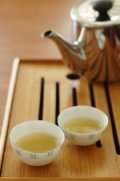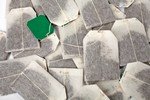Solving problems every tea drinker faces.
Exclusive subscriber benefits:
Receive four FREE quality ebooks worth $60
-
Save at least $5 during your first purchase
This may come as a surprise to many people.
Oolong tea is semi-fermented, so many people assume that its caffeine content lies between that of green tea (which is unfermented) and black tea (which is fully fermented).
Contrary to what many people believe, tea fermentation does not increase caffeine, it slightly reduces it. The two most important factors that influence tea caffeine are plant variety and leaf age.
This is explained in the article below:
Green Tea Caffeine Content Paradox
Less Caffeine Than Black Tea
Oolong tea is grown mainly in China and Taiwan. The Chinese tea plant contains less caffeine than the Indian tea plant.
The Indian tea plant is used to make black tea. Therefore oolong tea usually has less caffeine than black tea.
Less Caffeine Than Green Tea
 The younger the leaves,
the more caffeine they contain. This is especially true for a high grade green,
which is made from the youngest tea shoots.
The younger the leaves,
the more caffeine they contain. This is especially true for a high grade green,
which is made from the youngest tea shoots.
Oolong tea, made from more mature leaves, usually have less caffeine than green tea.
On the flip side, mature leaves contain less theanine, a sweet, natural relaxant that makes a tea much less caffeinated than it actually is.
That is the theory, anyway. When you try them, your body will instinctively tell you which is best for you.
Here are some tips will help you mitigate the oolong tea caffeine side effects.
1. Drink not more than 6 cups a day.
The UK Tea Council recommends drinking not more than 6 cups of tea or 300 milligrams of caffeine a day as being safe for most people.
A typical cup is 8 ounces or 225 milliliters. For green and black tea, 3 grams of leaves brew one cup.
When brewing oolong tea, try use a smaller cup for a more concentrated brew. Standard practice is to brew 3 grams of leaves in a 5-ounce of 150-milliliter cup.
2. Avoid oolong teabags.
 A 1996 study conducted by
Hicks found that drinking teabags gives twice the amount of caffeine as loose tea. To
quote Hicks:
A 1996 study conducted by
Hicks found that drinking teabags gives twice the amount of caffeine as loose tea. To
quote Hicks:
Extraction of caffeine ... was higher from the teabags than the loose leaves.
This is because loose tea can be infused 3 times and still tastes good. But an oolong teabag can only be used once.
3. Throw away the first infusion.
Decaffeinated tea usually tastes awful so I wouldn't recommend you go there. However, do you know that you can greatly reduce the caffeine content of your oolong tea by throwing away the first infusion?
Simply soak the tea leaves in hot water for 5 minutes and throw away the first infusion. According to the scientific study carried out by scientist Hicks, this will remove 70% of the oolong tea caffeine content.
In China, we call this tea washing, as it rinses away from dusts and pesticide residues that might be found in the tea leaves.
An oolong tea brew is more concentrated, so the second and third infusions will still be good, but with much less caffeine!
Finally, here's the caveat: the above tip will only work if you are drinking a quality oolong tea that can be infused or steeped 3 to 5 times. So it is important to drink quality! This usually refers to an loose oolong that has been harvested from high altitude.
An example is this Tieguanyin oolong tea and Wuyi rock tea.
New! Comments: Like This Story? Leave A Comment!
References
Hicks M.B.; Hsieh Y.-H.P.1; Bell L.N. Tea preparation and its influence on methylxanthine concentration .
Food Research International, Volume 29, Number 3, April 1996, pp. 325-330(6)
Back to Top of Oolong Tea Caffeine
Back to Green Tea Caffeine Main Page
Back to Amazing Green Tea Home
Solving problems every tea drinker faces.
Exclusive subscriber benefits:
Receive four FREE quality ebooks worth $60
Save at least $5 during your first purchase
Copyright� 2006-2025 Amazing-Green-Tea.com. All rights reserved.

